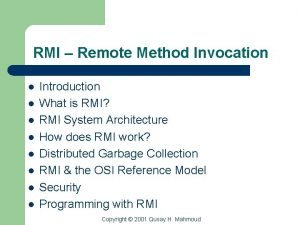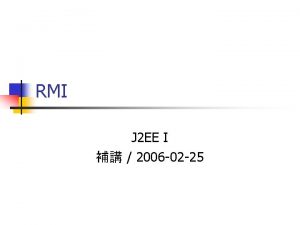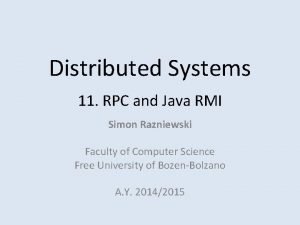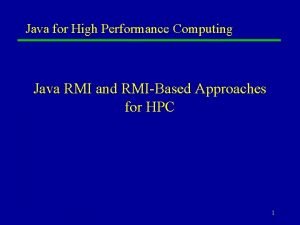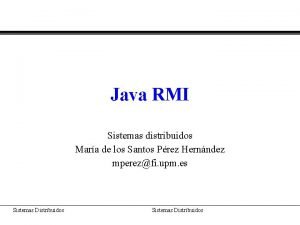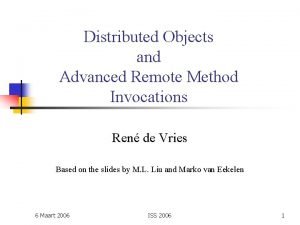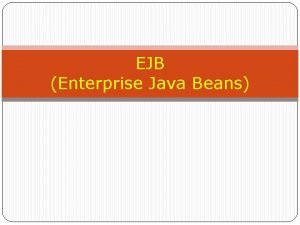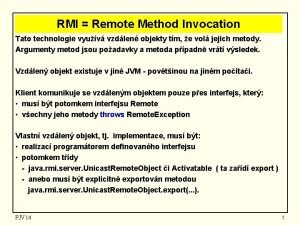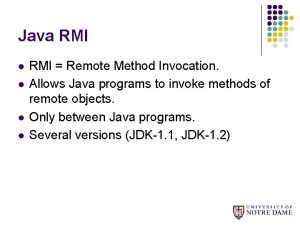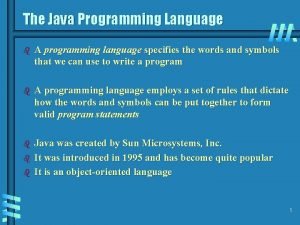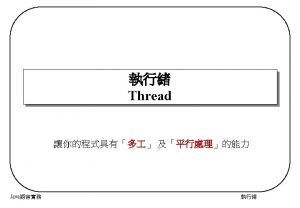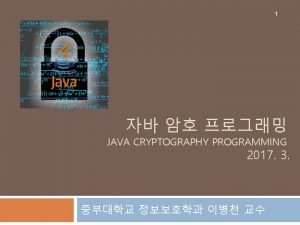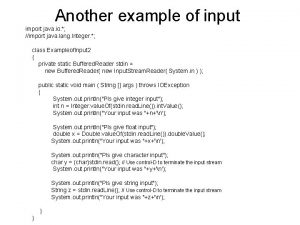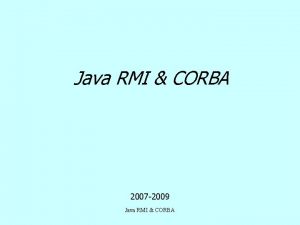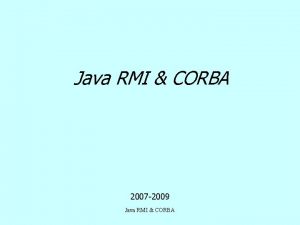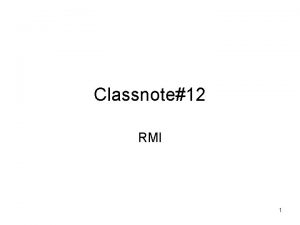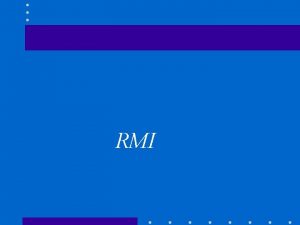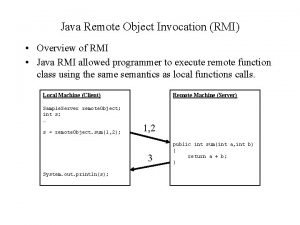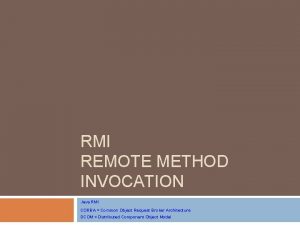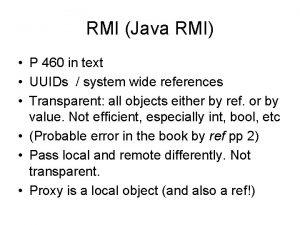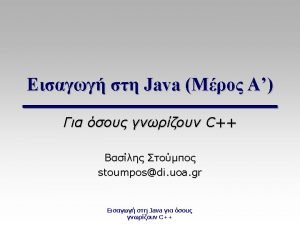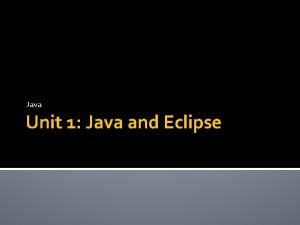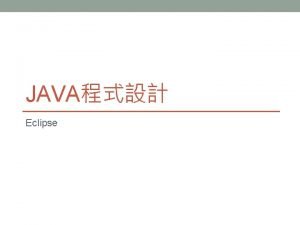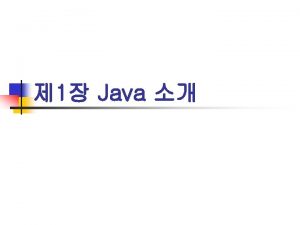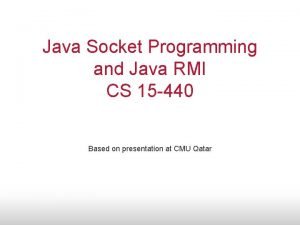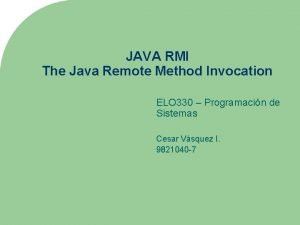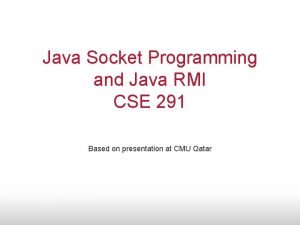Java RMI What is RMI RMI is an







![Use the interface public class Map. Client { public static void main(String[] args) throws Use the interface public class Map. Client { public static void main(String[] args) throws](https://slidetodoc.com/presentation_image_h2/1b9a5f7c122169dd9f0d91dcccd7755f/image-8.jpg)














- Slides: 22

Java RMI

What is RMI? • RMI is an RPC system for an object based language. • Objects provide a natural granularity for the binding of functions. – RMI allows a program to hold a reference to an object on a remote system and to call that object’s methods. • Client-Server architecture. – Server holds the object. – Client holds a small stub that accesses the object on the Server.

Remote Objects • What can be accessed? – Class must be designed to be remotely accessed: • It must implement the Remote interface • Usually extends one of the RMI communication classes (if you need your own client-server protocol or want to run some methods on the client, you can write your own). – Function calls only (not fields) – All methods throw a Remote. Exception

Classes • Interface – An interface containing all of the functions to export • Implementation – An object implementing this interface on the server • Stubs – Client-side object that implements the interface and communicates with the server object. Automatically generated using the ‘rmic’ command. • Skeleton – Server-side object that listens for remote requests and calls the implementing class. Handled automatically by Java 2.

Parameter Passing • Call by reference if the parameter implements Remote – An instance of the Stub object is created, serialized, and sent to the client. • If the client does not have the actual Stub code, it is downloaded from a web server. – Reference server object is leased by the client. Server object not garbage collected until no references remain. • Call by value otherwise – Implemented through serialization (Java makes marshalling fairly simple).

Define the interface public interface Global. Map extends Remote { public void put(String key, Object data) throws Remote. Exception; public Object get(String key) throws Remote. Exception; }

Implement the interface. public class Global. Map. Impl extends Unicast. Remote. Object implements Global. Map { private Map m; public void put(String key, Object data) throws Remote. Exception { m. put(key, data); } public Object get(String key) throws Remote. Exception { return m. get(key); }; public Global. Map. Impl() throws Remote. Exception { m=Collections. synchronized. Map(new Hash. Map()); } public static void main(String[] args) throws Exception { Global. Map. Impl gm=new Global. Map. Impl(); Naming. rebind("Global. Map", (Remote)gm); } }
![Use the interface public class Map Client public static void mainString args throws Use the interface public class Map. Client { public static void main(String[] args) throws](https://slidetodoc.com/presentation_image_h2/1b9a5f7c122169dd9f0d91dcccd7755f/image-8.jpg)
Use the interface public class Map. Client { public static void main(String[] args) throws Exception { System. set. Security. Manager(new RMISecurity. Manager()); Global. Map gm=(Global. Map)Naming. lookup("Global. Map"); try { if (args[0]. equals("put")) { gm. put(args[1], args[2]); } else if (args[0]. equals("get")) { Object obj=gm. get(args[1]); System. out. println("Got : "+obj); } } catch (Remote. Exception re) {} } }

Sample app overview

Compiling the Server • Compile the interface and implementation normally. • Create the stub file using: rmic –v 1. 2 Global. Map. Impl

Compiling the client • Need access to the Global. Map. class file, but NOT the implementation file. • Compile normally.

Running the server • Copy the remote object. class files to a web server (Jini includes a simple one). – You should only need the interface and the stub files on the web server. • Create a file named policy. all with the following: grant { permission java. security. All. Permission "", ""; };

Running the server • Run the rmiregistry service so the client can find the remote object. – CLASSPATH should NOT contain the class files. – Run: rmiregistry • Run the server – CLASSPATH must include the implementation class. – In another shell, run: java –Djava. security. policy=policy. all – Djava. rmi. server. codebase=http: //XXX/ Global. Map. Impl

Running the client • Run the client java –Djava. security. policy=policy. all – Djava. rmi. server. codebase=http: //XXX/ Map. Client put key data • What does the command line mean? – –Djava. security. policy=policy. all • Lists the security restrictions on code. At the very least Stubs need access to the network. – –Djava. rmi. server. codebase=http: //XXX/ • Tells where to find the stub for any Remote objects I’m exporting.

A more interesting client • Chat. Client uses Global. Map as a lookup service. – The “Listen” client registers a name in the map – The “Send” client queries the map for the Listener. Sends a message to the Listener. public interface Chat. Client extends Remote { public void notify(String str) throws Remote. Exception; }

public class Chat. Client. Impl extends Unicast. Remote. Object implements Chat. Client { public void notify(String str) throws Remote. Exception { System. out. println("Got a message: "+str); } public static void main(String[] args) throws Exception { System. set. Security. Manager(new RMISecurity. Manager()); Global. Map gm=(Global. Map)Naming. lookup("Global. Map"); if (args[0]. equals("listen")) { gm. put(args[1], new Chat. Client. Impl()); } else if (args[0]. equals("send")) { Object obj=gm. get(args[1]); Chat. Client ch=(Chat. Client)obj; ch. notify(args[2]); } } }

Activation • So far, objects are instantiated all the time. – Want to register services that won’t often be used. – Don’t want to restart all services whenever we reboot • rmid – Starts other servers on demand (like inetd on unix) – Registration is persistent

Activation • Coding changes: – Extend Activatable – Create a new constructor with Activation. Id and Marshalled. Object parameters. – Create an Activation. Group containing information to start the server(policy file, class name, etc) – Register rmid with rmiregistry

Other issues • Server must call inactive() to signal it is willing to terminate. – Can terminate even if there are remote references if there are no ongoing operations. • Must deal with saving our state. – When we are made inactive, current state is not saved. – Application must store their state somewhere and know where to find it when they returns

Running it • Start rmid –J-Dsun. rmi. activation. exec. Policy=none • This gives you the same level of security listed in the Jini book. To learn more about the new security model, see: http: //developer. java. sun. com/developer/produ cts/jini/execpolicy. html – This creates a directory named ‘log’ in the current directory which holds persistent state. • Start the server – Java –Djava. rmi. server. codebase=http: //XXX/ Djava. security. policy=policy. all Global. Map. Impl http: //XXX/ policy. all -

Security • A lot of issues – How should we limit who can register? – What permissions should downloaded stubs have? – How should we authenticate stub/server connections? • Most of these are unsolved (or at least unimplemented) issues in Java.

Sample Code • The code for these slides (as well as code for an Activateable version of the server) is available at: – http: //www. cs. washington. edu/elemar/rmi. tgz • The Jini book also has a reasonable RMI tutorial.
 Rmi layers
Rmi layers Java.rmi.server.codebase
Java.rmi.server.codebase Java rmi in distributed system
Java rmi in distributed system Java rmi performance
Java rmi performance Sistemas distribuidos java
Sistemas distribuidos java Rmic.somee.com
Rmic.somee.com Java bean vs enterprise java bean
Java bean vs enterprise java bean Java rmi
Java rmi Remote method invocation in distributed system
Remote method invocation in distributed system Java import util
Java import util Import java.util.
Import java.util. Java import java.util.*
Java import java.util.* Programming language b
Programming language b Java
Java Java thread import
Java thread import Import java.util.*
Import java.util.* Java.util.random
Java.util.random Import java.util.*
Import java.util.* Pengertian awt dan swing pada java
Pengertian awt dan swing pada java Import java.applet.applet
Import java.applet.applet Import java.io.* in java
Import java.io.* in java Import java.awt.event.*;
Import java.awt.event.*; Rmi boulder co
Rmi boulder co
